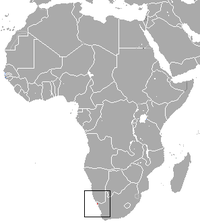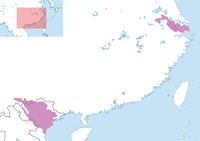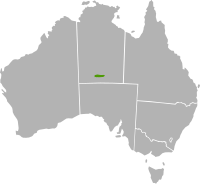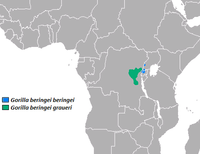Rare species
A rare species is a group of organisms that are very uncommon, scarce, or infrequently encountered. This designation may be applied to either a plant or animal taxon, and is distinct from the term endangered or threatened. Designation of a rare species may be made by an official body, such as a national government, state, or province. The term more commonly appears without reference to specific criteria. The International Union for Conservation of Nature does not normally make such designations, but may use the term in scientific discussion.[1]
Rarity rests on a specific species being represented by a small number of organisms worldwide, usually fewer than 10,000. However, a species having a very narrow endemic range or fragmented habitat also influences the concept.[2][3] Almost 75% of known species can be classified as "rare".[4]
Rare species are species with small populations. Many will move into the endangered or vulnerable category if the negative factors affecting them continue to operate. Well-known examples of rare species - because these are large terrestrial animals - include the Himalayan brown bear, Fennec fox, Wild Asiatic buffalo, or the Hornbill.
They are not endangered yet, but classified as "at risk",[5][6] although the frontier between these categories is increasingly difficult to draw given the general paucity of data on rare species. This is especially the case in the world Ocean where many 'rare' species not seen for decades may well have gone extinct unnoticed, if they are not already on the verge of extinction like the Mexican Vaquita.[7]
A species may be endangered or vulnerable, but not considered rare if it has a large, dispersed population. IUCN uses the term "rare" as a designation for species found in isolated geographical locations. Rare species are generally considered threatened because a small population size is less likely to recover from ecological disasters.
Rare plants can be classified based on the size and distribution of their populations. Some species may be rare because they consist of only a few individuals, are confined to a limited geographic area, or both. Certain rare plants are found sparsely distributed across a wide area. Others might have a large number of individuals that are concentrated in a very small area, such as a single county or canyon. The rarest plants typically have both a small number of individuals and a very limited geographic range.
Assessments of the status of rare plants are conducted using the best available data and consider various factors, including:
- Total number of occurrences and the condition of these populations
- Population size
- Extent of range and area occupied
- Trends in population size and distribution over the short and long term
- Nature, severity, and urgency of threats
- Number of occurrences that are protected and actively managed
- Intrinsic vulnerability of the species
- Specificity to environmental conditions[8]
A rare plant's legal status can be observed through the USDA's Plants Database.
Rare species
[edit]| Name | Image | IUCN Red List conservation status | Last sighting | Estimated population | Endemic geographic location | |||||
|---|---|---|---|---|---|---|---|---|---|---|
| Common name | Scientific name | Lowest wildlife | Highest wildlife | Captive | Total lowest | Total highest | ||||
| Ethiopian amphibious rat | Nilopegamys plumbeus | Critically Endangered, Possibly Extinct | 1927 | ? | ? | 0 | ? | ? | 
| |
| Zuniga's melanomys | Melanomys zunigae | Critically Endangered, Possibly Extinct | 1949 | ? | ? | 0 | ? | ? | Lima Department, Peru | |
| De Winton's golden mole | Cryptochloris wintoni | Critically Endangered, Possibly Extinct | c. 1950 | ? | ? | 0 | ? | ? | 
| |
| Northern Sumatran rhinoceros | Dicerorhinus sumatrensis lasiotis |  |
Critically Endangered, Possibly Extinct | After 1960 1 | ? | ? | 0 | ? | ? | Myanmar & Malay Peninsula, Malaysia / Thailand |
| Christmas Island shrew | Crocidura trichura | Critically Endangered, Possibly Extinct | 1986 | ? | ? | 0 | ? | ? | Christmas Island | |
| Cuban ivory-billed woodpecker | Campephilus principalis bairdii |  |
Critically Endangered | 16 March 1987 | ? | ? | 0 | ? | ? | Cuba |
| Garrido's hutia | Capromys garridoi | Critically Endangered, Possibly Extinct | 1989 | ? | ? | 0 | ? | ? | Banco de los Jardins y Jardinillos, Canarreos Archipelago, Cuba | |
| Angel Island mouse | Peromyscus guardia | Critically Endangered, Possibly Extinct | 1991 | ? | ? | 0 | ? | ? | 
| |
| Emma's giant rat | Uromys emmae | Critically Endangered, Possibly Extinct | 1994 | ? | ? | 0 | ? | ? | Owi Island, Indonesia | |
| Wimmer's shrew | Crocidura wimmeri | Critically Endangered | 2008 | ? | ? | 0 | ? | ? | 
| |
| Baiji | Lipotes vexillifer | Critically Endangered, Possibly Extinct | 2018 | ? | ? | 0 | ? | ? | 
| |
| Puebla deer mouse | Peromyscus mekisturus | Critically Endangered, Possibly Extinct | 1948 | 0 | 50 | 0 | 0 | 50 | 
| |
| Dwarf hutia | Mesocapromys nana | Critically Endangered, Possibly Extinct | 26 October 1951 | 0 | 50 | 0 | 0 | 50 | Zapata Swamp, Cuba | |
| New Zealand greater short-tailed bat | Mystacina robusta | Critically Endangered, Possibly Extinct | 1967 | 0 | 50 | 0 | 0 | 50 | 
| |
| Kouprey | Bos sauveli | Critically Endangered, Possibly Extinct | 1988 | 0 | 50 | 0 | 0 | 50 | 
| |
| Montane monkey-faced bat | Pteralopex pulchra | Critically Endangered, Possibly Extinct | 17 May 1990 | 0 | 50 | 0 | 0 | 50 | 
| |
| San Felipe hutia | Mesocapromys sanfelipensis | Critically Endangered, Possibly Extinct | 1978 | 0 | 99 | 0 | 0 | 99 | Cayo de Juan Garcia & Cayos de San Felipe, Cuba | |
| Gloomy tube-nosed bat | Murina tenebrosa | Critically Endangered, Possibly Extinct | 1962 | 1 | 1 | 0 | 1 | 1 | Tsushima Island & Yakushima, Japan | |
| Fernandina Island Galápagos tortoise | Chelonoidis niger phantasticus | Critically Endangered, Possibly Extinct | N/A | 1 | 5 | 0 | 1 | 5 | Fernandina Island, Ecuador | |
| Aru flying fox | Pteropus aruensis |  |
Critically Endangered, Possibly Extinct | 1887 | 1 | 49 | 0 | 1 | 49 | Trangan, Indonesia |
| Horrid ground-weaver | Nothophantes horridus | Critically Endangered | N/A | 9 | 9 | ? | 9 | 9 | Cattedown, Plymouth, United Kingdom of Great Britain and Northern Ireland | |
| Northern white rhinoceros | Ceratotherium simum cottoni | Critically Endangered (Possibly Extinct in the Wild) | N/A | ? 2 | ? 2 | 2 2 | 2 2 | 2 2 | 
| |
| One-striped opossum | Monodelphis unistriata | Critically Endangered, Possibly Extinct | 9 April 1899 | 2 | 10 | 0 | 2 | 10 | 
| |
| Yangtze giant softshell turtle | Rafetus swinhoei | Critically Endangered | N/A | 2 | 4 | 1 | 3 | 5 | 
| |
| American ivory-billed woodpecker | Campephilus principalis principalis |  |
Critically Endangered | 8 April 2022 | 3 (as of 8 April 2022)[9] | 3 (as of 8 April 2022)[9] | 0 | 3 (as of 8 April 2022)[9] | 3 (as of 8 April 2022)[9] | 
|
| Guadalcanal rat | Uromys porculus | Critically Endangered, Possibly Extinct | Between 1886 and 1888 | 3 | 3 | 0 | 3 | 3 | 
| |
| Emperor rat | Uromys imperator | Critically Endangered, Possibly Extinct | c. 1960s | 3 | 3 | 0 | 3 | 3 | 
| |
| Key tree-cactus | Pilosocereus robinii | Critically Endangered | N/A | 7 | 15 | 7 | 15 | Florida Keys, Mexico, Puerto Rico | ||
| Lord Howe Island stick insect | Dryococelus australis | Critically Endangered | N/A | < 10 (as of 3 October 2021)[10] | < 10 (as of 3 October 2021)[10] | < 10 (as of 3 October 2021)[10] | < 10 (as of 3 October 2021)[10] | Ball's Pyramid, Australia | ||
| Vaquita | Phocoena sinus |  |
Critically Endangered | N/A | 10 (as of 5 May 2022)[11] | 10 (as of 5 May 2022)[11] | 0 | 10 (as of 5 May 2022)[11] | 10 (as of 5 May 2022)[11] | 
|
| Saola | Pseudoryx nghetinhensis |  |
Critically Endangered | 2013 | 20 (as of 30 October 2021)[12] | < 100 (as of 20 August 2021)[13] | 0[14] | 20 (as of 30 October 2021)[12] | < 100 (as of 20 August 2021)[13] | 
|
| Telefomin cuscus | Phalanger matanim | Critically Endangered, Possibly Extinct | 1997 | 40 | 40 | 0 | 40 | 40 | 
| |
| Gobi bear | Ursus arctos gobiensis | Critically Endangered | N/A | 51 (as of 27 May 2022)[15] | 51 (as of 27 May 2022)[15] | 0[16] | 51 (as of 27 May 2022)[15] | 51 (as of 27 May 2022)[15] | 
| |
| Māui dolphin | Cephalorhynchus hectori maui | Critically Endangered | N/A | 55 | 55 | 55 | 55 | 
| ||
| Cat Ba langur | Trachypithecus poliocephalus | Critically Endangered | N/A | 65 | 67 | 65 (as of March 2018)[17] | 67 (as of March 2018)[17] | 
| ||
| Indonesian Javan rhinoceros | Rhinoceros sondaicus sondaicus | Critically Endangered | N/A | 76 (as of 20 September 2022)[18] | 76 (as of 20 September 2022)[18] | 0 | 76 (as of 20 September 2022)[18] | 76 (as of 20 September 2022)[18] | 
| |
| Western Sumatran rhinoceros | Dicerorhinus sumatrensis sumatrensis | Critically Endangered | N/A | 75 (as of 18 December 2022)[19] | 85 (as of 18 December 2022)[19] | 10 | 85 | 95 | 
| |
| Alagoas curassow | Mitu mitu |  |
Extinct in the wild | N/A | 0 | 130 | 130 | 130 | 
| |
| Kākāpō | Strigops habroptilus |  |
Critically Endangered | N/A | 149 | 149 | 149 | 149 | Anchor Island, Codfish Island / Whenua Hou, Little Barrier Island and Maud Island, New Zealand | |
| Philippine eagle | Pithecophaga jefferyi | Critically Endangered | N/A | 200 breeding pairs | 200 breeding pairs | 200 breeding pairs | 200 breeding pairs | 
| ||
| Cross River gorilla | Gorilla gorilla diehli | Critically Endangered | N/A | 200 | 300 | 0 | 200 | 300 | 
| |
| Bornean rhinoceros | Dicerorhinus sumatrensis harrissoni | Critically Endangered | N/A | < 250 (as of 24 February 2020)[20] | < 250 (as of 24 February 2020)[20] | 0 | < 250 (as of 24 February 2020)[20] | < 250 (as of 24 February 2020)[20] | East Kalimantan, Indonesia & Sarawak, Malaysia | |
| Malabar large-spotted civet | Viverra civettina | Critically Endangered, Possibly Extinct | 1993 | 249 | 249 | 0 | 249 | 249 | 
| |
| Devils Hole pupfish | Cyprinodon diabolis | Critically Endangered | N/A | 263 (as of 29 September 2022)[21] | 300 (as of 11 May 2022)[22] | 475 (as of 4 May 2022)[23] | 475 (as of 4 May 2022)[23] | Devils Hole, Death Valley National Park, United States of America | ||
| North Atlantic right whale | Eubalaena glacialis | Critically Endangered | N/A | 366 | 366 | 366 | 366 | 
| ||
| Black softshell turtle | Nilssonia nigricans |  |
Critically Endangered | N/A | 150 | 150 | 300 | 450 | 450 | Sultan Bayazid Bastami shrine at Chittagong |
| California condor | Gymnogyps californianus |  |
Critically Endangered | N/A | 446 | 446 | 446 | 446 | 
| |
| Central rock rat | Zyzomys pedunculatus | Critically Endangered | N/A | 800 | 800 | 0 | 800 | 800 | 
| |
| Wild Bactrian camel | Camelus ferus | Critically Endangered | N/A | 950 | 950 | 950 | 950 | 
| ||
| Eastern lowland gorilla | Gorilla beringei graueri | Critically Endangered | N/A | < 5,000 (as of 7 October 2022)[24] | < 5,000 (as of 7 October 2022)[24] | 1 | < 5,000 or 5,000 | < 5,000 or 5,000 | 
| |
Notes:
- 1 Last recorded that 7 were in captivity in 1960, in zoos, circuses etc., in the International Zoo Yearbook II. Reports that there is a small population left in Malay Peninsula and Myanmar.
- 2 On 19 March 2018, the last known Northern white rhinoceros male died, but his and another male's sperm was collected and has been used to fertilize eggs as part of a de-extinction effort. Last two known Northern white rhinoceros are both female and held in captivity in the Ol Pejeta Conservancy, Kenya. Unknown if anymore exist in the wildlife and if none exist in the wildlife they would be functionally extinct.
See also
[edit]- Abundance (ecology)
- Biodiversity Action Plan
- Chelonoidis nigra abingdonii
- Common species
- Critical depensation
- Endangered Species Recovery Plan
- Rare Species Conservation Centre
References
[edit]- ^ "Assessment Process". www.iucnredlist.org. Retrieved 2017-11-14.
- ^ R. MacNally and G. W. Brown, Reptiles and Habitat Fragmentation in the Box-ironbush Forests of Central Victoria, Australia: Predicting Compositional Change and Faunal Nested-ness, Oecologia 128:116–125 (2001).
- ^ Prendergast, J. R.; Quinn, R. M.; Lawton, J. H.; Eversham, B. C.; Gibbons, D. W. (1993-09-23). "Rare species, the coincidence of diversity hotspots and conservation strategies". Nature. 365 (6444): 335–337. Bibcode:1993Natur.365..335P. doi:10.1038/365335a0.
- ^ Dinerstein, Eric (2013) The Kingdom of Rarities. Island Press. ISBN 9781610911955.
- ^ "Rare Species". www.encyclopedia.com. Retrieved 2017-11-15.
- ^ "IUCN – A brief history". IUCN. 2017-10-06. Archived from the original on 2017-11-15. Retrieved 2017-11-15.
- ^ Briand, Frederic (October 2012). "Species Missing in Action - Rare or Already Extinct?". National Geographic.
- ^ "What is a rare plant?". www.fs.usda.gov. Retrieved 2024-04-12.
- ^ a b c d Multiple lines of evidence indicate survival of the Ivory-billed Woodpecker in Louisiana
- ^ a b c d Dryococelus australis (Lord Howe Island Phasmid)
- ^ a b c d The critically endangered vaquita is not doomed to extinction by inbreeding depression
- ^ a b Searching for the Saola in the Annamite Mountains
- ^ a b IUCN SSC experts urge for immediate action to find Saola before it’s too late
- ^ Saola
- ^ a b c d Population of endangered Gobi bears exceeds 50 in Mongolia
- ^ Gobi Bear Project
- ^ a b CAT BA LANGUR
- ^ a b c d 2022 State of the Rhino Report
- ^ a b Two Horned Rhino – Sumatran Rhinoceros Profile
- ^ a b c d Bornean Rhinoceros
- ^ Devils Hole pupfish population at 19-year high
- ^ Critically endangered pupfish on the rise on 50th anniversary of official monitoring effort
- ^ a b The Devil’s Hole pupfish has paddled back from the brink in a hellish desert domain
- ^ a b Eastern Lowland Gorilla
External links
[edit]Further reading
[edit]- Gorbunov, Y. N., Dzybov, D. S., Kuzmin, Z. E. and Smirnov, I. A. 2008. Methodological recommendations for botanic gardens on the reintroduction of rare and threatened plants. Botanic Gardens Conservation International (BGCI).

